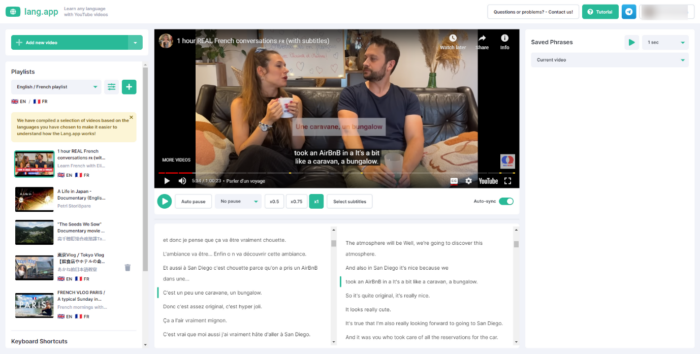How Do You Learn a Language to Native Speaker Level?
Read other articles:
Back to posts
Table of Contents

To reach a native speaker level in a language, one or more of the following must apply:
- You’re a child in a strong learning environment
- You have a native-speaking teacher with you at all times
- You have certain personal qualities and the right tools at your disposal
Given that most people reading this won’t be able to achieve numbers one or two, if you want to reach a native-speaker level of fluency, you’ll need to focus on number three.
Perhaps you’re already at a moderate to high level with the language but you just can’t step up a notch to be more fluent. Or, if you’re just starting to learn a language, maybe you want to make sure you acquire the language efficiently from the start.
Either way, it’s not easy to be fluent in a foreign tongue — but it’s easier if you have the right personal qualities and tools to access.
So, what are they?
Read on because I’m going to teach you a new word in English!
Three personal qualities you need to be proficient in a language
The “soft skills” you need to learn a language are often overlooked. The focus is usually on the hard skills of speaking, reading, writing and listening. You’ll need certain personal attributes before you even open a textbook or attend a class if you aspire to reach an elevated level of language fluency.
The most important of these are:
- Motivation
- Self-confidence
- Ataraxia
The first two are fairly self-explanatory; the third one probably raised an eyebrow — whatta-raxia?
Ataraxia is an Ancient Greek word used in English. It means freedom from distress, worry or anxiety. Other words we could use are equanimity or serenity.

These are words not usually associated with learning a foreign language. The main point is that learners acquire language best when they are free of anxiety. Language expert Stephen Krashen stressed this point often.
This goes counter to the general wisdom of language learning, which is geared towards getting people to speak in front of others (regardless of whether they’re ready to), putting students on the spot, and testing them frequently.
Krashen argued that if you can absorb language in a stress-free environment, you’ll start speaking it when you’re ready to — just like most children do.
So, unless you’re motivated to learn and can build self-confidence by learning without anxiety, it’s unlikely that the input you receive (i.e., what you’re trying to learn) will stick. There will be blockages to learning, which Krashen termed affective filters.
Lack of motivation, lack of self-confidence and learning anxiety are all affective filters that hinder language learning — and can prevent reaching any degree of fluency.
What sets native speakers apart?
When we talk about learning a language to a “native speaker level”, we mean with excellent fluency and, most likely, thinking in that language.
But a learner can speak with a good degree of fluency and be adept at reading and writing but will still stand out like a sore thumb among true native speakers of the language.
Understanding what defines mother tongue speakers, apart from correct sentence constructions and pronunciation, can help when we plan how to learn a language.
Native speakers generally display the following:
- An accent/dialect depending on where they’re from and their upbringing/education (think of how a New Yorker differs from an Atlanta native or how a Harvard graduate’s accent differs from an uneducated farmworker’s).
- A full range of non-verbal body language to accompany their use of language (think of Italian hand gestures, Thai smiles or Western handshakes).
- Cultural reference points and insight from experiences shared by the majority of individuals from the area, based on history, geography, values, way of life, food, music, media and other factors that define a people.

These have traditionally been difficult to learn from a non-immersive learning environment, i.e., without living among first-language speakers.
Fortunately, the tools are now available to provide a more immersive learning experience that can help those aiming for language fluency accelerate their learning.
What tools do you need to reach a native speaker level?
To learn a language efficiently — provided the required personal qualities discussed above are in place — we need to receive comprehensible input in an anxiety-free environment.
This entails passive learning input like listening and reading as well as active output (speaking and writing). Listening and watching should be the focus of the tools we seek for native-speaker level proficiency —which probably rules out many of the language learning apps that focus almost entirely on conversation.
By listening and watching, we can hone not only our knowledge of the language but also the non-verbal and regional variations we discussed above.
Following are a few irreplaceable tools you need if you’re striving for more fluency and want to learn your foreign language more efficiently than with the current methods:
Subtitled video
Video with subtitles provides almost unlimited access to engaging, relevant content in the native tongue. YouTube, Netflix and other video platforms can provide an immersive experience in the target language, with multi-sensual stimulation that enables more rapid learning.
Whether movie trailers, full movies, documentaries or shorter clips, you receive exposure to different accents, body language and cultures, helping you learn the language in context. You can pause, rewind, watch again and focus on certain phrases or pronunciations. This is a very different learning experience from traditional language-learning methods, which are often delivered in your native tongue (rather than the target language) and provide little or no context.
Video apps
Our free Chrome extension works with subtitled YouTube or Netflix videos and accelerates language learning. It’s aimed at helping learners of a moderate to higher level improve rapidly but can be used by anyone who wants to learn a language from native speakers.
Using AI to enrich the learning experience, you acquire language naturally and learn new words and phrases in context, with the ability to switch between languages, save new phrases in your personalized library and learn at your own pace at any time. No need to keep referring to a dictionary!

Local music and literature
Learning music lyrics is a highly engaging and motivational way for most people to learn a second language and delve deeper into the culture. Many music videos have subtitles on YouTube. There are also plenty of websites that specialize in transcribing song lyrics, translating them and interpreting their meaning.
If books are more your thing, reading local literature is a great way to go deeper into a language. For beginners, kids’ books are an excellent resource but if you’re already at a moderate to high level of proficiency, every culture has its Classics that provide cultural insight as well as reading practice. Want to learn Spanish? How about Don Quixote by Cervantes? Want to learn Russian? How about Crime and Punishment by Dostoyevsky?

A language-learning buddy
Nothing beats conversing with speakers of the mother tongue if you’re trying to emulate their level.
There are many ways to connect with native speakers. One way is to find someone in your target foreign language who wants to learn your first language. That’s a win-win exchange if ever there was one!
Feedback from a native-speaking language learner is usually even more effective than from the average person because they understand the challenges of language learning and can often provide precisely the type of direction you need.
The challenge is in finding the right level of student to practice with — but it’s easier now with online access to language-learning communities. You don’t necessarily have to find someone in your local area to learn a language effectively anymore.

Accelerate your journey to native speaker level
If you want to master a foreign language fluently like a first-language speaker and even learn to think in that language, you can’t hope to do that without some form of immersion into it.
Video is the next best thing to “being there” and provides an amazing opportunity to ramp up your learning. Download our free Chrome extension to get smarter with your language learning and accelerate your journey.
Read other articles:
Back to posts
